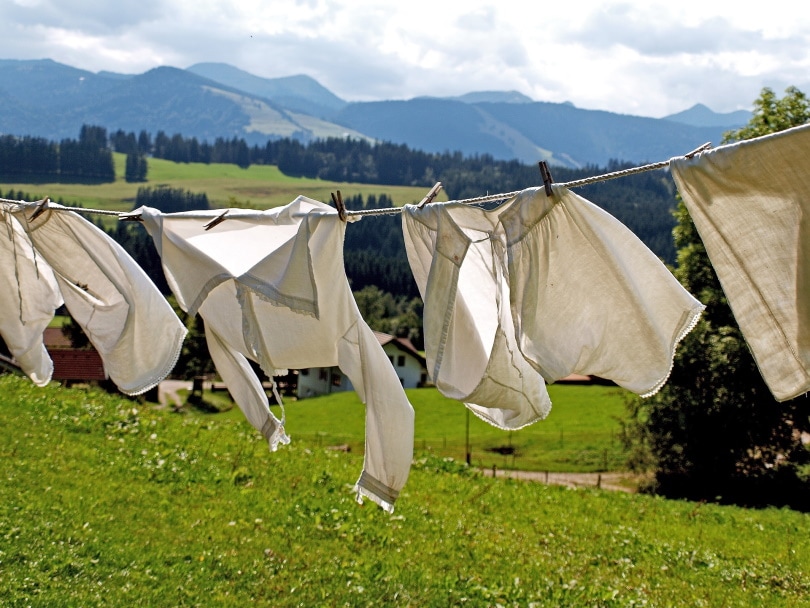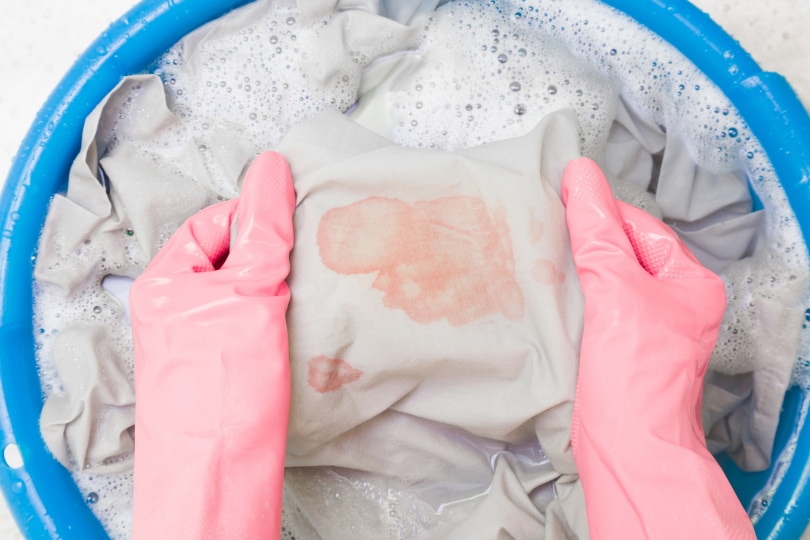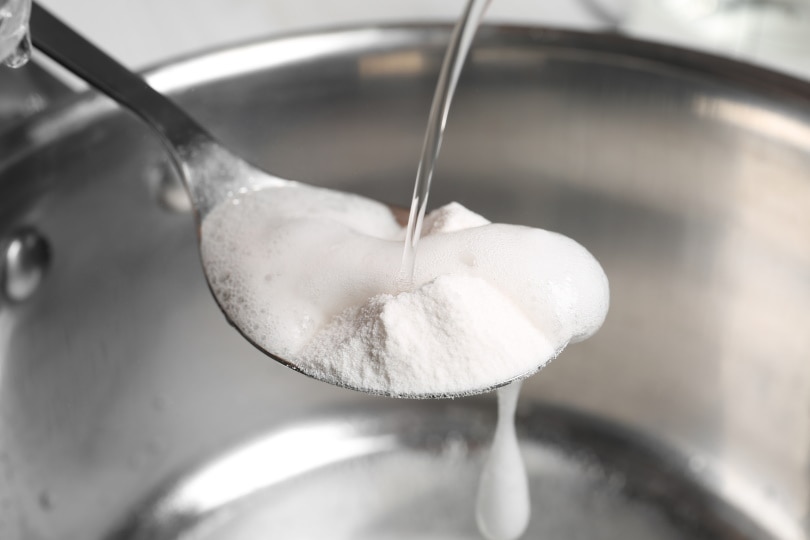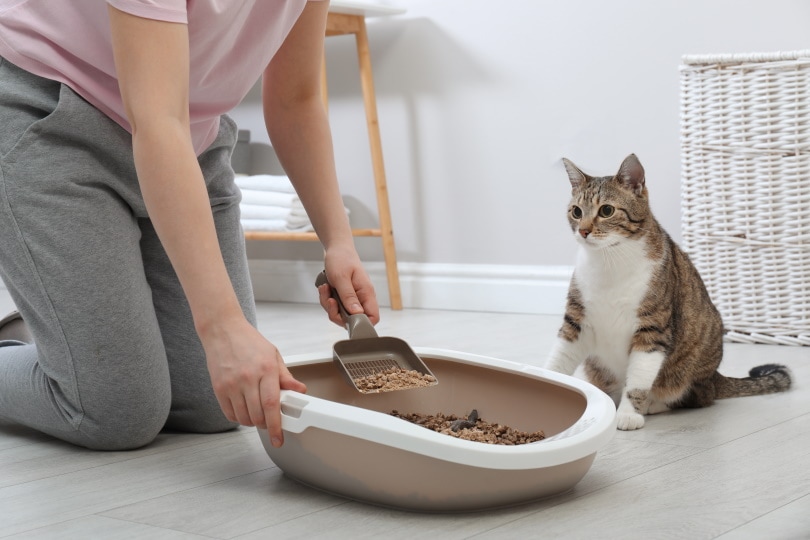
Click to Skip Ahead
Cleaning your cat’s litter box is one of the disadvantages of being a cat owner, but it’s more pleasant than dealing with urine-soaked clothes. Uric acid from cat urine is a potent substance that can linger on fabric for several months or years if it is not treated and removed correctly.
Professional cleaners can remove the stain permanently, but you can treat the stain at home unless the urine has damaged a sensitive fabric like silk that requires dry cleaning.
Before Treating the Garments
Most of the products for treating pet stains are probably part of your standard cleaning supplies, but you may need to pick up a few of the items at the grocery store. Although most homeowners depend on their machines for drying clothes, these cleaning methods work best when using a clothesline to dry the garments. You can install a temporary line by tying a rope between two trees or attaching a line across your backyard deck or gazebo.
The supplies you’ll need for removing urine include:
Each of the methods in this article uses a different cleaner, but you follow the same pre-washing routine for each one.
Before treating the stain, hold the garment under cold running water for 3 to 4 minutes. Hold onto the clean portions of the fabric to ensure the water saturates every inch of the stain. Use paper towels to blot the garment dry carefully but avoid putting too much pressure on the stain. Scrubbing the stain can embed it deeper into the fibers and require additional cleaning sessions to remove the smell and stain.
The Bleach Method
You can use ordinary bleach for white clothes, but you’ll need oxygen bleach for colored garments.
1. Fill a Washing Basin with Water and Bleach
Add ½ cup of bleach to 4 gallons of water and mix it carefully using a large mixing spoon and rubber gloves. Avoid using any stain removers before putting the clothes in the bleach solution. Some commercial products contain ammonia, and the ammonia residue can convince your pet to urinate on the same garment.

2. Soak the Clothes in the Solution
Colored garments can sit in the liquid for 3 or 4 hours, but you’ll probably need to soak white clothes overnight. Keep the container in a secure location such as the garage or laundry room to prevent pets or small children from disturbing it.
3. Clean Clothes in the Washer with Lukewarm Water
Add 1 cup of your laundry detergent to the wash along with 1 cup of bleach. Use the standard spin cycle to clean the clothes but avoid using the dryer after the cycle is complete. The dryer’s heat can embed any remaining traces of uric acid, and you’ll have to repeat the process if the stain and smell linger.
4. Hang the Clothes on the Clothesline to Air Dry
To avoid fading, move your colored garments away from direct sunlight. Air drying can take 24 hours during cooler months, and you may have to transfer the line inside if it’s too cold outside. Before hanging up your clothes, you can vacuum them to remove any particles of debris and dirt deposited by the wind.
The Vinegar Method
Each year, you can find more products in the vinegar aisle of the grocery store, but some of the vinegar can create new stains if you use the wrong type. To prevent additional staining and aroma, use distilled white vinegar in the pre-wash and final wash.
1. Add Vinegar and Baking Soda to the Washing Basin
Use 1 cup of vinegar and 3 cups of water for minor stains, but you can increase the vinegar to 2 cups, add ½ cup of baking soda, and decrease the water amount to one cup for stubborn urine stains.

2. Soak the Garments Overnight in the Vinegar solution
You can soak lighter stains for a shorter period but keeping the clothes in the solution overnight will not damage the fabric if you use the correct ratio of vinegar and water.
3. Run the Clothes in the Washer Without Using Laundry Detergent
Use lukewarm or cold water to wash the garments in the spin cycle.
4. Dry the Clothes on the Line
After your clothes are dry, smell them to ensure the odor is gone. Massive stains sometimes require multiple cleanings before the odor and stain are eliminated.

The Enzymatic Detergent Method
Enzymatic cleaners cost more than vinegar and bleach, but brands explicitly designed to remove pet stains typically require fewer repeat cleanings than household products. Enzymatic products can remove odors from various products and surfaces but be sure to purchase detergent made for the washer. If you accidentally use a cleaner designed to clean carpet, the product can damage your clothes.
Our Favorite Product
Hepper Advanced Bio-Enzyme Pet Stain & Odor Eliminator Spray is our favorite all-purpose cleaner for pet messes. It permanently lifts the very worst stains and odors, making clean up and accident prevention breeze. Hepper offers a 100% guarantee, which is a great bonus! Learn more about it here.
- ADVANCED ENZYMATIC CLEANER - Penetrates the most stubborn smells and stains at the deepest molecular...
- FOR ANY MESS, ON ANY SURFACE - This pet odor eliminator cleans your carpets, floors, furniture,...
- FRESH, NATURAL ODOR - Our unique formulation doesn't rely on dangerous or unpleasant chemical...
At Pet Keen, we’ve admired Hepper for many years, and decided to take a controlling ownership interest so that we could benefit from the outstanding products of this cool cat company!
1. Wash the Dirty Garments in the Washer
Unlike the previous methods, you do not have to pre-soak the clothes. Set the water temperature according to the recommendation on the garment label and wash on the spin cycle.
2. Smell the Garments Before Air Drying
If you detect a slight urine odor, repeat the process until the smell disappears.

3. Hang the Clothes on the Clothesline Outdoors
If you can still smell urine after drying, you can rewash the clothes with an enzymatic cleaner, but most high-quality products will remove the scent with one or two cleanings.
Why Does My Cat Repeatedly Urinate on My Clothing?
Although some inexperienced pet parents may conclude that cats have nefarious reasons for urinating on beloved garments, the causes are less complex.
An Unruly Litter Box
The most common reason for a healthy cat to urinate on clothes is a filthy litter box. Cats like to poke around with their paws in the litter box before going, and they would rather use a sweatshirt or blanket that gives them a similar sensation than going on a hard floor or carpet. However, they will urinate anywhere if their favorite textures are absent.
You can keep them focused on the litter box by removing the waste every day. Some litter contains heavy deodorizers and fragrances that mask the scent of feces and urine temporarily. Unfortunately, the litter additives can make you forget to clean the box as often as you should. If your cat has problems when the litter stays clean, you can try using a different litter material and adding an attractant to keep your pet on target.

Medical Conditions
Senior cats and adults with medical problems are more likely to urinate outside of the litter box than healthy adult cats. Aging kitties may have cognitive issues that disrupt their ability to remember the location of the litter box or mobility problems that keep them from climbing into the box.
Bladder infections, kidney stones, kidney disease, and liver disease can cause cats to urinate more frequently in unusual places. If the problem occurs more than once, you can set up a full health screening appointment with your veterinarian.
Stress
Moving to a new city or returning after a long trip puts additional stress on your cat, but even a tiny change can keep your pet from visiting the litter box. Cats are skilled at hiding their emotions, and you may not realize the creature is stressed until you pick up a urine-soaked garment.
If you rearrange the furniture and move the litter box, you may irritate your cat enough that it urinates in the original spot where your clothes are now located. Use an attractant in the litter when you move it and reward your cat with a treat when it uses the new location. Eventually, the animal will adapt to the change and accept the new litter box location.
Conclusion
Professional cleaners can treat dry-cleaned clothes with commercial enzymatic detergents to remove urine odors and stains, but you can use common household chemicals to treat your cotton and polyester garments at home. Bleach, vinegar, baking soda, and enzymatic cleaners are excellent products for stain and odor removal, but you may have to treat the clothes several times depending on the severity and age of the stain.
Visiting your veterinarian to ensure your cat’s problem is not health-related is critical if your pet frequently urinates away from the litter box.
Featured Image Credit: wilhei, Pixabay








